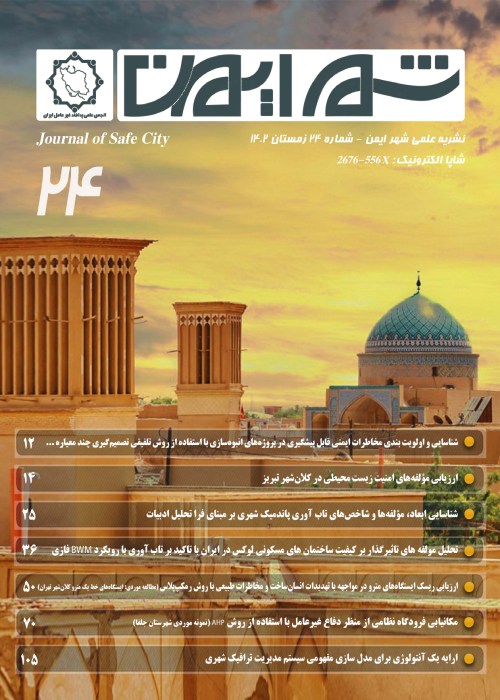Investigating the vulnerability of cities with passive defense in Tehran 6th District
Given the high stock of investment and establishment of many facilities and critical centers in cities and metropolises and most importantly the large number of population around them, this settlements in the event of human-induced threats, will suffer significant financial and material losses.Zone # 6 of Tehran, with 251,384 population (2.81% of city population) and 20 km2 area (3.2% of city area), is one of the main municipal zones of Tehran (Iran center of statistics, 2006). Major land-uses, like ministries, embassies, universities, general hospitals and medical centers, big financial firms and so on, manifest the high importance of this region on local and national scale. Thus, it is necessary to pay close attention to issues concerning crisis management in this area.To analyze the vulnerability, using the Matlab software, the knowledge base and rules database are built using expert opinions. Mamdani fuzzy method was selected for the inference system and the membership functions to assess the vulnerability and finaly the results obtained from the fuzzification of indices in Matlab software are exported to the GIS software to generate vulnerability maps.the resuls shows total blocks in the GIS environment were 29053. Vulnerable classes assigned as: 320 blocks, 1.1%, as very low vulnerable; 3249 blocks, 11.2%, as low vulnerable; 11576 blocks, 39.8%, as moderate vulnerable; 12024 blocks, 41.04%, as high vulnerable; 1881 blocks, as 6.48%, as very high vulnerable. With moving from the north to the south of the region, the vulnerability has an increasing trend because the northern part of the area has a fairly large passageway to the south, with resistant and young buildings. Also, Kargar Street is not in a good condition due to its low width and the multiplicity of illuminated intersections and the absence of intersections of different levels. The vulnerability of Kargar Street is visible after the Jalal Al Ahmad highway in its eastern body because low-density land uses are located in the western body and in the east one is revers. The presence of highly vulnerable bridges (Hafez-Taleghani, Karimkhan-Gharani and Enghelab-Hafez bridges) that leads to closure of these streets and spread of vulnerability to around, created the most dangerous zone in Sixth District of Tehran because the collapse of these bridges will be a complicated problem of relief and rescue operations.
- حق عضویت دریافتی صرف حمایت از نشریات عضو و نگهداری، تکمیل و توسعه مگیران میشود.
- پرداخت حق اشتراک و دانلود مقالات اجازه بازنشر آن در سایر رسانههای چاپی و دیجیتال را به کاربر نمیدهد.


